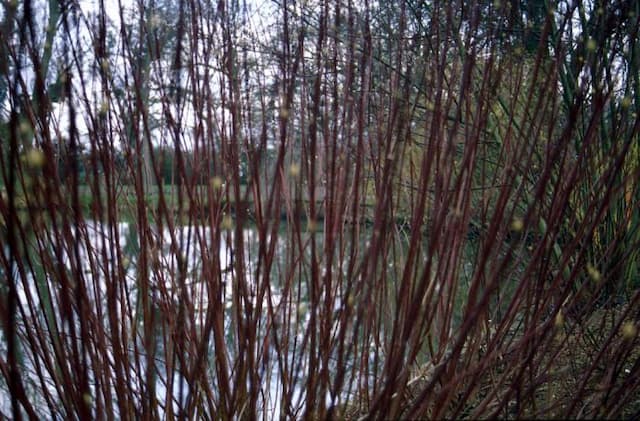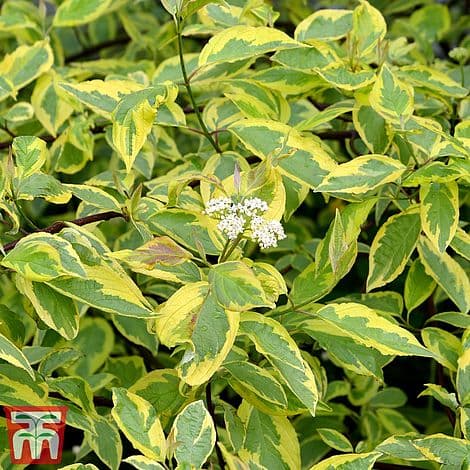Pink Flowering Dogwood Cornus florida f. rubra











ABOUT
Cornus florida f. rubra, commonly known as the pink flowering dogwood, is a visually striking plant well-known for its showy springtime blossoms. It is characterized by an abundance of large, floral-looking displays that are not actually flowers, but special leaves called bracts. These bracts are a vivid pink, giving the impression of a pink cloud when the tree is in full bloom. The true flowers of this plant are small and inconspicuous, clustered at the center of these prominent bracts. As the seasons change, the foliage also offers visual interest; the leaves are ovate and have a smooth, green surface that transitions to rich reds and purples in the autumn before they fall off. The bark of the pink flowering dogwood is also noteworthy. It can be described as having a blocky, puzzle-like pattern that adds an additional touch of texture to the landscape. This pattern is more prominent as the plant ages. After the flowering season, the plant produces round, berry-like fruits that are a favorite of many birds. These fruits are glossy and initially a green color, maturing to a bright red that provides a striking contrast to the foliage and persists into the winter, lending additional interest to the garden during the colder months. Overall, the pink flowering dogwood is celebrated for its decorative and changing appearance throughout the year, with multiseasonal appeal thanks to its spring blooms, summer foliage, fall colors, and winter fruits.
About this plant
 Names
NamesSynonyms
Pink Flowering Dogwood, Red Flowering Dogwood, Pink Dogwood.
Common names
Benthamidia florida f. rubra, Cynoxylon floridum f. rubro, Cornus florida var. rubra.
 Toxicity
ToxicityTo humans
The plant commonly known as Flowering Dogwood is not considered highly toxic to humans. However, if ingested, parts of the plant, especially the fruit, can cause mild symptoms. These symptoms may include stomach upset, nausea, and vomiting. It is generally advised to avoid consumption of any part of the Flowering Dogwood due to these potential adverse effects.
To pets
Flowering Dogwood is also not highly toxic to pets, but ingestion can cause minor symptoms, similar to those in humans. If pets consume parts of the dogwood tree, such as the berries, they might experience gastrointestinal discomfort, including vomiting and diarrhea. It is best to keep an eye on pets to prevent them from eating parts of this plant to avoid these unpleasant but typically non-life-threatening symptoms.
 Characteristics
CharacteristicsLife cycle
Perennials
Foliage type
Deciduous
Color of leaves
Green
Flower color
Pink
Height
15-30 feet (4.6-9.1 meters)
Spread
15-30 feet (4.6-9.1 meters)
Plant type
Tree
Hardiness zones
5-9
Native area
North America
Benefits
 General Benefits
General Benefits- Landscape Aesthetics: The Pink Dogwood (Cornus florida f. rubra) is a highly ornamental tree that provides striking beauty to landscapes with its showy pink flowers in spring.
- Wildlife Habitat: The tree offers shelter and nesting sites for various bird species, as well as producing fruit that is a food source for wildlife.
- Shade and Cooling: It provides shade in landscapes, which can help reduce cooling costs for nearby structures and create comfortable outdoor living spaces.
- Seasonal Interest: Pink Dogwood adds year-round interest with flowering in spring, bright foliage in fall, and textural bark in the winter.
- Low Maintenance: Once established, Pink Dogwoods require relatively low maintenance, thriving without the need for constant care or attention.
- Erosion Control: The root system of the Pink Dogwood helps stabilize soil and prevent erosion, making it useful for planting on slopes or areas prone to soil loss.
 Medical Properties
Medical Properties- Traditional remedy for malaria: Cornus florida f. rubra has been used in folk medicine as a treatment for malaria.
- Antipyretic properties: The bark is believed to possess fever-reducing properties.
- Analgesic effects: Some cultures have used the plant to alleviate pain.
- Gastrointestinal aid: It has been used to treat digestive disturbances.
- Tonic for health: The bark, in particular, has been used historically as a general tonic to improve health and vitality.
 Air-purifying Qualities
Air-purifying QualitiesThis plant is not specifically known for air purifying qualities.
 Other Uses
Other Uses- Cornus florida f. rubra, commonly known as pink dogwood, can be used in woodworking projects for its beautiful grain and hard wood, making it suitable for crafting small specialty items like tool handles, inlays, and decorative boxes.
- The bark of pink dogwood trees has been traditionally used for dyeing fabric a reddish-brown color, by utilizing the tannins present in the bark.
- In landscaping, pink dogwood is often planted as a feature tree for its stunning springtime blooms, which can enhance the aesthetic appeal of parks and gardens.
- The strong and stiff wood of pink dogwood is sometimes used in the construction of golf club heads, particularly for those seeking traditional materials.
- Pink dogwood's dense wood can also be used to make musical instruments, such as woodwind instruments that benefit from the fine acoustic properties of the wood.
- The fruit of the pink dogwood, although not widely consumed, can be used to make small batch jams or jellies when adequately sweetened and processed.
- Pink dogwood trees can serve as host plants for various butterfly and moth species, whose larva feed on the leaves, thus supporting local biodiversity.
- The tree's ability to thrive in a variety of soil conditions makes pink dogwood an excellent choice for erosion control on slopes and banks.
- In ritual and symbolic plantings, the pink dogwood is sometimes used as a representation of love and affection, stemming from its heart-shaped bracts and soft pink color.
- As a source of organic material, fallen pink dogwood leaves and twigs can be composted to create a rich soil conditioner for gardens and landscapes.
Interesting Facts
 Feng Shui
Feng ShuiThe Flowering Dogwood is not used in Feng Shui practice.
 Zodiac Sign Compitability
Zodiac Sign CompitabilityThe Flowering Dogwood is not used in astrology practice.
 Plant Symbolism
Plant Symbolism- Beauty: With its stunning pinkish-red bracts that bloom in spring, the Cornus florida f. rubra, commonly known as the Pink Dogwood, is often a symbol of beauty and grace in the natural world.
- Christian Symbolism: The Pink Dogwood is linked to Christianity; it is said that the tree's four petals shape a cross and the red color represents the blood of Christ.
- Renewal: As it is one of the first trees to flower in spring, the Pink Dogwood symbolizes rebirth and the rejuvenation of nature after winter.
- Eternal Love: Often given as a gift, it symbolizes undying love due to the enduring aspect of the hard wood and the long-lasting nature of the tree itself.
- Endurance: The tree's ability to withstand various environmental conditions makes it a symbol of strength and endurance.
 Water
WaterThe Pink Dogwood (Cornus florida f. rubra) should be watered deeply once a week, providing about an inch of water which translates to approximately 0.623 gallons per square foot. During hot or dry periods, water twice a week. Check the soil before watering; it should be moist but not soggy. Overwatering can lead to root rot, so ensure good drainage. The actual amount can vary depending on soil type and weather conditions, but consistency is key to maintain a healthy plant.
 Light
LightPink Dogwood thrives in partial shade to full sun. The ideal location offers morning sunlight with afternoon shade, or filtered light throughout the day. Direct, harsh afternoon sun can stress the plant, so a spot with some protection is advantageous especially in the hotter zones.
 Temperature
TemperaturePink Dogwoods prefer moderate temperatures, ideally between 60 to 75 degrees Fahrenheit, but they are hardy and can withstand winter chill down to around 0 degrees Fahrenheit. However, temperatures below this can damage the plant. During extreme heat, Pink Dogwoods require extra care and protection, as temperatures consistently above 90 degrees Fahrenheit can stress the tree.
 Pruning
PruningPrune Pink Dogwood to maintain its shape and remove any dead or diseased branches. The best time for pruning is late winter or early spring before the tree leafs out. Pruning during dormancy minimizes sap loss and stress to the tree. Pruning can be done annually, but major pruning should occur every two to three years for optimal health and aesthetics.
 Cleaning
CleaningAs needed
 Soil
SoilThe Pink Dogwood (Cornus florida f. rubra) thrives in organically rich, well-drained soil with a pH of 5.5 to 6.5. A good mix might include equal parts loamy soil, compost, and peat moss to ensure fertility and proper drainage. It's important to avoid soils that are too wet or poorly drained.
 Repotting
RepottingPink Dogwoods are typically planted outdoors and do not require repotting. However, if planted in a container, young trees should be repotted every 2-3 years to provide ample space for root growth.
 Humidity & Misting
Humidity & MistingPink Dogwoods prefer moderate humidity levels but are adaptable to the humidity found in most temperate outdoor environments. They do not have specific humidity requirements when planted outdoors in their appropriate climate.
 Suitable locations
Suitable locationsIndoor
Provide bright light, moderate water, and good air circulation.
Outdoor
Plant in partial shade, shield from intense heat.
Hardiness zone
5-9 USDA
 Life cycle
Life cycleThe Eastern Flowering Dogwood (Cornus florida f. rubra) begins its life cycle when the seeds are dispersed, often by birds, following the fruiting period in late summer to autumn. After seed dispersal, germination occurs, typically requiring a period of cold stratification to break seed dormancy. Once the seed germinates, a seedling emerges and grows into a small sapling, developing a root system and foliage through photosynthesis. As the sapling matures into an adult tree, it develops a flowering structure; the trees bloom in early spring, displaying the characteristic pink to red bracts that surround the small, inconspicuous flowers. After pollination by insects, the flowers develop into berry-like drupes which mature by late summer, completing the reproductive stage. The tree then enters a period of dormancy during the colder months, conserving energy to restart the cycle with the next flowering season.
 Propogation
PropogationPropogation time
Late winter to early spring
The most popular method of propagation for the flowering dogwood (Cornus florida f. rubra) is from seed. The best time to sow seeds is in the fall, after they have been collected from ripe berries. The seeds need to go through a stratification process to break dormancy, which involves mixing the seeds with slightly moist sand and refrigerating them for 60 to 90 days at a temperature of approximately 33-40 degrees Fahrenheit (1-4 degrees Celsius). After stratification, the seeds can be sown in a prepared seedbed with well-draining soil, lightly covered with soil, and then they should be kept consistently moist. Seedlings usually emerge by spring if the conditions are favorable, and they can then be grown on until large enough to transplant to their final location.









